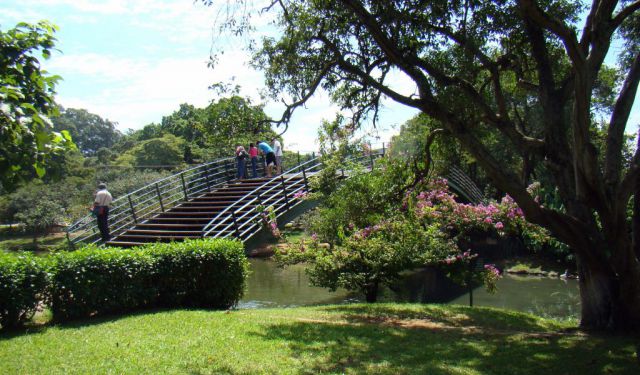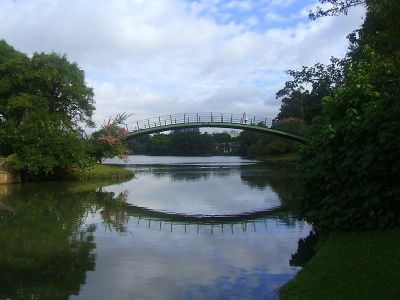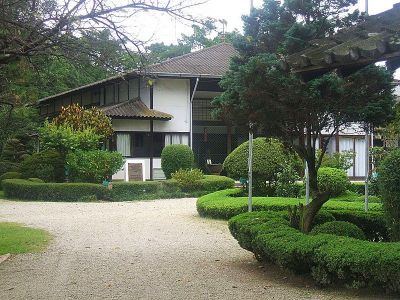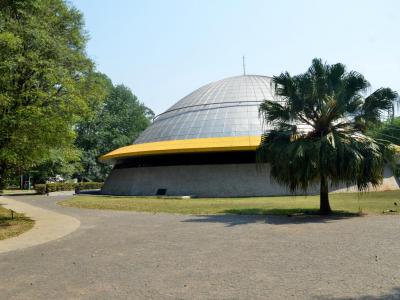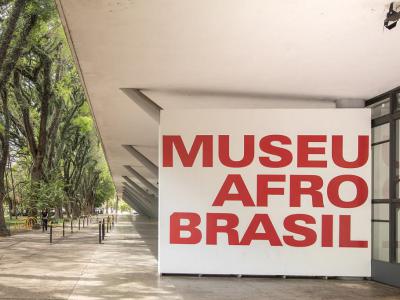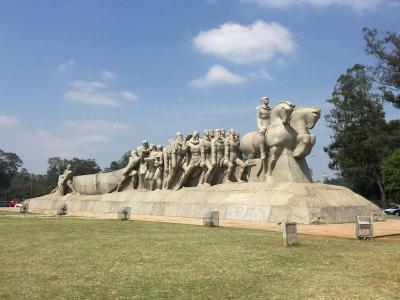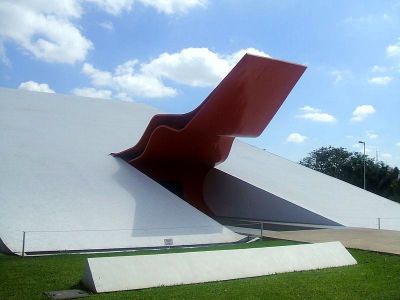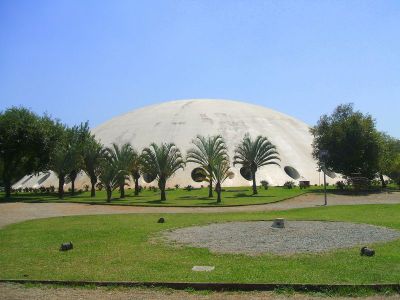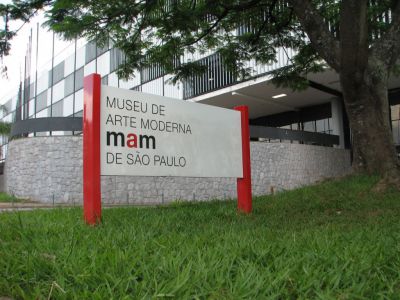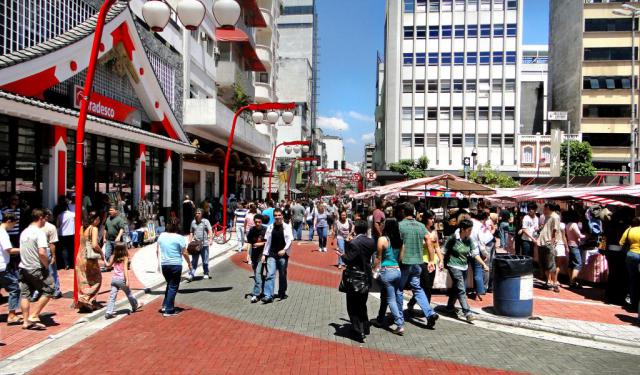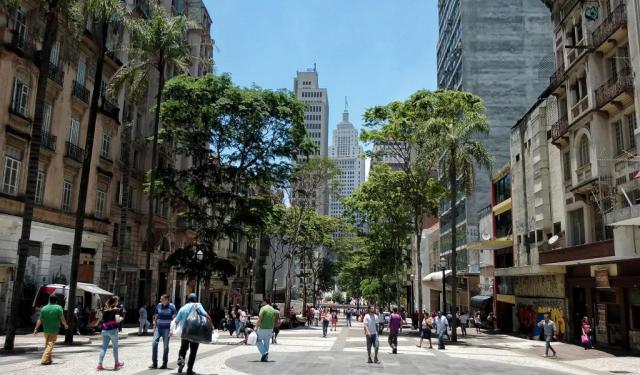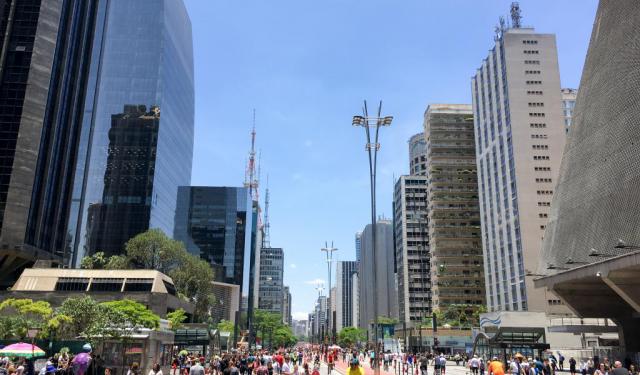Ibirapuera Park Walking Tour (Self Guided), Sao Paulo
Located in the very heart of Sao Paulo, Ibirapuera Park is the city's most famous attraction. The park was designed by architect Oscar Niemeyer together with landscapist Roberto Burle Marx. It opened to the public on the 21st August, 1954. With a total space of 2 million square meters, the park features a beautiful landscape, filled with lakes, fountains, monuments, theaters, playgrounds, fitness areas, courts, museums and other attractions of architectural and cultural interest.
Being the most visited park in Sao Paulo, Ibirapuera gathers in high season over 130 thousand visitors. The park also hosts several shows and events during the year, including São Paulo Fashion Week. Congresses and trade shows are held here regularly. Each weekend, visitors can enjoy live music shows delivered by different bands who come to the park for outdoor concerts.
Take this self-guided walking tour to discover the most popular attractions of this magnificent place.
Being the most visited park in Sao Paulo, Ibirapuera gathers in high season over 130 thousand visitors. The park also hosts several shows and events during the year, including São Paulo Fashion Week. Congresses and trade shows are held here regularly. Each weekend, visitors can enjoy live music shows delivered by different bands who come to the park for outdoor concerts.
Take this self-guided walking tour to discover the most popular attractions of this magnificent place.
How it works: Download the app "GPSmyCity: Walks in 1K+ Cities" from Apple App Store or Google Play Store to your mobile phone or tablet. The app turns your mobile device into a personal tour guide and its built-in GPS navigation functions guide you from one tour stop to next. The app works offline, so no data plan is needed when traveling abroad.
Ibirapuera Park Walking Tour Map
Guide Name: Ibirapuera Park Walking Tour
Guide Location: Brazil » Sao Paulo (See other walking tours in Sao Paulo)
Guide Type: Self-guided Walking Tour (Sightseeing)
# of Attractions: 9
Tour Duration: 2 Hour(s)
Travel Distance: 3.9 Km or 2.4 Miles
Author: DanaOffice
Sight(s) Featured in This Guide:
Guide Location: Brazil » Sao Paulo (See other walking tours in Sao Paulo)
Guide Type: Self-guided Walking Tour (Sightseeing)
# of Attractions: 9
Tour Duration: 2 Hour(s)
Travel Distance: 3.9 Km or 2.4 Miles
Author: DanaOffice
Sight(s) Featured in This Guide:
- Ibirapuera Park Footbridge
- Pavilhao Japones (Japanese Garden)
- Ibirapuera Planetarium
- Museu Afro Brasil (Afro-Brazilian Museum)
- Monumento as Bandeiras (Monument to the Bandeiras)
- Obelisk of Sao Paulo
- Ibirapuera Auditorium
- OCA -Lucas Nogueira Garcez Pavilion
- Modern Art Museum
1) Ibirapuera Park Footbridge
The Ibirapuera Park Footbridge, located in Sao Paulo, is an attractive architectural structure within the sprawling Ibirapuera Park. The footbridge spans across a tranquil pond within the park, adding to its visual appeal. Its sleek design features a series of curved steel arches that rise gracefully above the water, creating an elegant and inviting pathway.
One of the most captivating aspects of the footbridge is its integration with the surrounding landscape. Lush greenery and vibrant flora embrace the structure, making it feel like a natural extension of the park. As visitors stroll along the footbridge, they are treated to panoramic views of the park's expansive lawns, sparkling water features, and the iconic buildings of Ibirapuera Park, including the Museum of Contemporary Art and the Oca Exhibition Pavilion.
Beyond its architectural beauty, the footbridge serves a vital purpose by offering a convenient and safe pedestrian route within the park. It enhances accessibility for visitors, allowing them to easily navigate between different areas and attractions, whether they are heading towards the museums, gardens, or simply enjoying a leisurely walk in the park.
The Ibirapuera Park Footbridge has also become a gathering place for locals and tourists alike. It provides a space for people to pause, appreciate the natural surroundings, and take in the vibrant atmosphere of the park. It is not uncommon to see joggers, couples, families, and individuals enjoying a peaceful moment on the footbridge, immersing themselves in the beauty of the park and the city beyond.
One of the most captivating aspects of the footbridge is its integration with the surrounding landscape. Lush greenery and vibrant flora embrace the structure, making it feel like a natural extension of the park. As visitors stroll along the footbridge, they are treated to panoramic views of the park's expansive lawns, sparkling water features, and the iconic buildings of Ibirapuera Park, including the Museum of Contemporary Art and the Oca Exhibition Pavilion.
Beyond its architectural beauty, the footbridge serves a vital purpose by offering a convenient and safe pedestrian route within the park. It enhances accessibility for visitors, allowing them to easily navigate between different areas and attractions, whether they are heading towards the museums, gardens, or simply enjoying a leisurely walk in the park.
The Ibirapuera Park Footbridge has also become a gathering place for locals and tourists alike. It provides a space for people to pause, appreciate the natural surroundings, and take in the vibrant atmosphere of the park. It is not uncommon to see joggers, couples, families, and individuals enjoying a peaceful moment on the footbridge, immersing themselves in the beauty of the park and the city beyond.
2) Pavilhao Japones (Japanese Garden)
If you wish to relax after a hard day's work or a tough workout in the park, but, at the same time, would like to experience something exotic and different, the Pavilhão Japonês (Japanese Garden) is an ideal place for that. A symbol of friendship between Brazil and Japan, the garden is known as the "jewel of the Ibirapuera Park", and is spread over 7500 square meters, encompassing an abundance of plants (including bonsai trees), ponds and small lakes, filled with goldfish as well as Shoin-style buildings, and offering a glimpse into the Japanese culture.
The peculiarity of this park is in the fact that it was originally built in Japan, then taken apart, piece by piece, and reassembled in Sao Paulo in 1954, delivered as a gift for the fourth centenary of the city's foundation. The original Japanese materials - wood, volcanic rock, and Kyoto mud - of which the buildings and the garden have been made, facilitate a better cultural perception and entourage.
The garden's central building, created by Sutemi Horiguti, a professor at the University of Tokyo, is a replica of the Katsura Palace, the former summer residence of the Emperor in Kyoto, Japan, built between 1620 and 1624. It is divided into a hall and several adjoining rooms that house a display of samurai clothes, pottery, ceramics, costumes, and sculptures from several Japanese imperial dynasties. Upstairs is the Tea Room, known as chashitsu, used for traditional tea ceremonies.
The peculiarity of this park is in the fact that it was originally built in Japan, then taken apart, piece by piece, and reassembled in Sao Paulo in 1954, delivered as a gift for the fourth centenary of the city's foundation. The original Japanese materials - wood, volcanic rock, and Kyoto mud - of which the buildings and the garden have been made, facilitate a better cultural perception and entourage.
The garden's central building, created by Sutemi Horiguti, a professor at the University of Tokyo, is a replica of the Katsura Palace, the former summer residence of the Emperor in Kyoto, Japan, built between 1620 and 1624. It is divided into a hall and several adjoining rooms that house a display of samurai clothes, pottery, ceramics, costumes, and sculptures from several Japanese imperial dynasties. Upstairs is the Tea Room, known as chashitsu, used for traditional tea ceremonies.
3) Ibirapuera Planetarium
Ibirapuera Park is a wonderful place, abundant with museums, theaters and other places of cultural interest. Of these, particularly notable is the Planetarium. Designed by a group of architects (Eduardo Corona, Roberto G. Tibau and Antônio Carlos Pitombo), the Planetarium was inaugurated in 1957, to become the first of its kind institution in South America. It reopened in September 2006, after seven years of restoration works.
The outline of the Planetarium resembles an alien spaceship, with a metal dome of 40 feet in diameter, circled by a yellow wooden disk. In the course of the restoration, the firm Carl Zeiss installed in the showroom a large StarMaster projection screen. The showroom itself, seating 280, has also been designed by Zeiss. It allows the audience a much closer look at planets and stars. Visitors to the Planetarium are also invited to take part in different presentations organized regularly during weekends.
Why You Should Visit:
A nice (and very affordable) activity to do in town; the surroundings are great and the visit itself is rewarding.
Among other things, you can watch a presentation about the sky of São Paulo.
Overall, highly recommended for both adults and children.
Tip:
The place can get very busy, so plan to arrive 1 hour before the show to pick up tickets at the front desk.
Another suggestion is to buy tickets online, as there are many sessions during the day, all at specific times.
The outline of the Planetarium resembles an alien spaceship, with a metal dome of 40 feet in diameter, circled by a yellow wooden disk. In the course of the restoration, the firm Carl Zeiss installed in the showroom a large StarMaster projection screen. The showroom itself, seating 280, has also been designed by Zeiss. It allows the audience a much closer look at planets and stars. Visitors to the Planetarium are also invited to take part in different presentations organized regularly during weekends.
Why You Should Visit:
A nice (and very affordable) activity to do in town; the surroundings are great and the visit itself is rewarding.
Among other things, you can watch a presentation about the sky of São Paulo.
Overall, highly recommended for both adults and children.
Tip:
The place can get very busy, so plan to arrive 1 hour before the show to pick up tickets at the front desk.
Another suggestion is to buy tickets online, as there are many sessions during the day, all at specific times.
4) Museu Afro Brasil (Afro-Brazilian Museum)
Museu Afro-Brasil is a perfect place to enrich one's knowledge of the African-Brazilian community and history. Representing six major themes (Africa, Work and Slavery, Sacred and Profane, Afro-Brazilian Religions, History and Memory, and Art), the collections feature more than 3000 exhibits, which have been gathered over the course of 20 years, and comprise religious artifacts, pieces of art from Africa, books and various written sources on the history of Brazilian slavery. The museum outlines the important contribution made by black Brazilians into the national culture. It forms part of the Manoel da Nóbrega Pavilion, which spreads over an area of 11,000 square meters.
The actual building, housing the museum, was created by Oscar Niemeyer, assisted by a team of architects, and opened in 1953, in time for the celebrations of São Paulo's 400th anniversary. The museum itself was established in 2004. Its collection includes some of the most fascinating statues and a definite must-see for a tourist's eye. One such exhibit is the statue of Zumbi, a former slave, who escaped to become the warrior leader of Quilombo dos Palmares. It stands 2.2 meters high, and was inaugurated on November 20, for the celebration of the "Black Awareness Day" in 2011.
Another notable piece is the Navio Negreiro (the Slave Ship) Room, which is indeed one of the most magnificent exhibits at the museum. The ship commemorates the enslaved Africans who made a journey across the Atlantic to Brazil, against their will. Book lovers definitely must visit the African-Brazilian Library, which is also part of the museum. Its collection includes more than 6000 titles, among which are books, theses, journals and articles about African-Brazilian history.
Why You Should Visit:
Great permanent exhibition (top floor) along with surprising temporary exhibits (on other floors). Interessantissimo and extremely unique, shining a spotlight on some of the art & culture of the native tribes in Africa, situations they have endured and treasured artifacts from many generations.
Tip:
There is no information at all in English so if you don't speak Portuguese it gets a little overwhelming after a while which can detract from the experience. Best visited with a pre-booked guide or you could try using Google translate in the picture mode, or download the app and bring earphones.
The actual building, housing the museum, was created by Oscar Niemeyer, assisted by a team of architects, and opened in 1953, in time for the celebrations of São Paulo's 400th anniversary. The museum itself was established in 2004. Its collection includes some of the most fascinating statues and a definite must-see for a tourist's eye. One such exhibit is the statue of Zumbi, a former slave, who escaped to become the warrior leader of Quilombo dos Palmares. It stands 2.2 meters high, and was inaugurated on November 20, for the celebration of the "Black Awareness Day" in 2011.
Another notable piece is the Navio Negreiro (the Slave Ship) Room, which is indeed one of the most magnificent exhibits at the museum. The ship commemorates the enslaved Africans who made a journey across the Atlantic to Brazil, against their will. Book lovers definitely must visit the African-Brazilian Library, which is also part of the museum. Its collection includes more than 6000 titles, among which are books, theses, journals and articles about African-Brazilian history.
Why You Should Visit:
Great permanent exhibition (top floor) along with surprising temporary exhibits (on other floors). Interessantissimo and extremely unique, shining a spotlight on some of the art & culture of the native tribes in Africa, situations they have endured and treasured artifacts from many generations.
Tip:
There is no information at all in English so if you don't speak Portuguese it gets a little overwhelming after a while which can detract from the experience. Best visited with a pre-booked guide or you could try using Google translate in the picture mode, or download the app and bring earphones.
5) Monumento as Bandeiras (Monument to the Bandeiras)
The Monument to the Bandeiras (Monumento às Bandeiras), situated in Sao Paulo's Ibirapuera Park, is an impressive sculpture that stands 12 meters tall, spans 50 meters in length, and measures 15 meters in width. It holds the distinction of being one of the world's largest sculptures and remains a highly popular tourist attraction. Crafted by the skilled sculptor Victor Brecheret, this magnificent artwork was unveiled on January 25, 1953, in Armando Salles de Oliveira Square.
The monument holds historical significance as it was gifted to the city of Sao Paulo on its 399th anniversary. It pays homage to the Bandeirantes Paulistas expeditions, which played a pivotal role in expanding the boundaries of Sao Paulo during the 16th to 18th centuries, as these brave explorers embarked on quests for gold.
Depicting an expedition led by two equestrians, the sculpture showcases a diverse group of individuals, including Indians, Africans, Mestizos, and Portuguese, who accompany them. Together, they can be seen pulling a canoe, which served as their means of travel along rivers. It is worth noting that Victor Brecheret dedicated an impressive 30 years of his life to the creation of this majestic masterpiece.
The monument holds historical significance as it was gifted to the city of Sao Paulo on its 399th anniversary. It pays homage to the Bandeirantes Paulistas expeditions, which played a pivotal role in expanding the boundaries of Sao Paulo during the 16th to 18th centuries, as these brave explorers embarked on quests for gold.
Depicting an expedition led by two equestrians, the sculpture showcases a diverse group of individuals, including Indians, Africans, Mestizos, and Portuguese, who accompany them. Together, they can be seen pulling a canoe, which served as their means of travel along rivers. It is worth noting that Victor Brecheret dedicated an impressive 30 years of his life to the creation of this majestic masterpiece.
6) Obelisk of Sao Paulo
The Obelisk of São Paulo, located in Ibirapuera Park in the vibrant city of São Paulo, stands as an important monument steeped in historical significance. Serving as a lasting tribute to the Constitutionalist Revolution of 1932, this grand structure proudly holds the distinction of being the largest monument in São Paulo. With its towering height of 72 meters, the Obelisk of São Paulo commands attention and admiration from all who visit.
The visionary artist behind this remarkable obelisk is Galileo Ugo Emendabili, an Italo-Brazilian sculptor who arrived in Brazil in 1923. Emendabili's creative prowess and dedication to his craft are evident in the meticulous design and construction of this magnificent monument. Crafted entirely from pure travertine marble, the obelisk exudes a timeless elegance and serves as a testament to the artistic and architectural prowess of its creator.
The unveiling of the Obelisk of São Paulo took place on July 9, 1955, a significant date that marked the first anniversary of the inauguration of Ibirapuera Park. The park itself is a cherished green space in the heart of São Paulo, known for its sprawling lawns, beautiful gardens, and diverse cultural attractions. The Obelisk, rising majestically within this verdant oasis, adds a sense of grandeur and historical importance to the park's landscape.
The São Paulo Obelisk stands as a symbol of the 1932 Constitutionalist Revolution, a major uprising against the federal government. It represents the courage and determination of those who fought for autonomy and rights in Brazil's history.
The visionary artist behind this remarkable obelisk is Galileo Ugo Emendabili, an Italo-Brazilian sculptor who arrived in Brazil in 1923. Emendabili's creative prowess and dedication to his craft are evident in the meticulous design and construction of this magnificent monument. Crafted entirely from pure travertine marble, the obelisk exudes a timeless elegance and serves as a testament to the artistic and architectural prowess of its creator.
The unveiling of the Obelisk of São Paulo took place on July 9, 1955, a significant date that marked the first anniversary of the inauguration of Ibirapuera Park. The park itself is a cherished green space in the heart of São Paulo, known for its sprawling lawns, beautiful gardens, and diverse cultural attractions. The Obelisk, rising majestically within this verdant oasis, adds a sense of grandeur and historical importance to the park's landscape.
The São Paulo Obelisk stands as a symbol of the 1932 Constitutionalist Revolution, a major uprising against the federal government. It represents the courage and determination of those who fought for autonomy and rights in Brazil's history.
7) Ibirapuera Auditorium
Ibirapuera Park offers a wide range of attractions for music enthusiasts beyond the regular live band concerts. Situated within the park, the remarkable Ibirapuera Auditorium was envisioned by architect Oscar Niemeyer in 1950, but its construction in stone was completed only half a century later. This iconic venue has become one of the top tourist destinations in Sao Paulo, attracting visitors with its diverse musical events, breathtaking spectacles, captivating concerts, vibrant festivals (including the renowned "Batuka!" international drum fest), and even fashion shows.
Moreover, the Auditorium effortlessly transforms into a cinema theater, accommodating movie festivals and premieres. Its exterior is characterized by a striking combination of white and red colors. The distinctive trapezoid shape of the building is crafted using reinforced concrete. Inside, the Auditorium features three primary areas: the foyer, the stage, and the stalls, all adorned in a captivating shade of red. With exceptional acoustics and seating capacity for over 800 people, it provides an immersive experience for the audience. The underground level of the venue houses administrative offices, a music school, dining areas, dressing rooms, and other essential facilities. Additionally, the Auditorium frequently hosts open-air concerts and festivals, further enhancing its allure as a dynamic entertainment space.
Moreover, the Auditorium effortlessly transforms into a cinema theater, accommodating movie festivals and premieres. Its exterior is characterized by a striking combination of white and red colors. The distinctive trapezoid shape of the building is crafted using reinforced concrete. Inside, the Auditorium features three primary areas: the foyer, the stage, and the stalls, all adorned in a captivating shade of red. With exceptional acoustics and seating capacity for over 800 people, it provides an immersive experience for the audience. The underground level of the venue houses administrative offices, a music school, dining areas, dressing rooms, and other essential facilities. Additionally, the Auditorium frequently hosts open-air concerts and festivals, further enhancing its allure as a dynamic entertainment space.
8) OCA -Lucas Nogueira Garcez Pavilion
OCA is an exhibition hall inside Ibirapuera Park in Sao Paulo. The palace is hard to miss for its enormous, 10,000 square meters, white-painted dome. This magnificent structure was designed and constructed by Oscar Niemeyer in 1951, to commemorate the city's 400th anniversary. Originally known as Pavilhão Lucas Nogueira Garcez, the building was named after a traditional Native American residence, OCA.
OCA was formerly a museum of Aeronautics and Folklore, which then moved out and the building was refurbished. The exterior has been preserved pretty much in its original form, only repainted a sharper white color, whereas the interior has been thoroughly renovated and added with beautiful curves and ramps. Given the large amount of exhibits, a new air conditioning system had to be installed. Today, OCA is known to be the largest air-conditioned museum in the world. Occasionally, it houses touring exhibitions, e.g. of Indian or Chinese art.
OCA was formerly a museum of Aeronautics and Folklore, which then moved out and the building was refurbished. The exterior has been preserved pretty much in its original form, only repainted a sharper white color, whereas the interior has been thoroughly renovated and added with beautiful curves and ramps. Given the large amount of exhibits, a new air conditioning system had to be installed. Today, OCA is known to be the largest air-conditioned museum in the world. Occasionally, it houses touring exhibitions, e.g. of Indian or Chinese art.
9) Modern Art Museum
The São Paulo Museum of Modern Art is a prominent cultural institution located within the beautiful surroundings of Ibirapuera Park in São Paulo. The museum, founded by Francisco Matarazzo Sobrinho and Yolanda Penteado in 1948, is a non-profit organization dedicated to the preservation, exhibition, and promotion of modern and contemporary art in Brazil.
Designed to emulate the renowned Museum of Modern Art in New York City, São Paulo Museum of Modern Art occupies a striking building that forms part of the architectural ensemble envisioned by the iconic Brazilian architect, Oscar Niemeyer, in 1954. The structure underwent renovations in 1982 by Lina Bo Bardi, another influential architect, to accommodate the museum's growing needs.
The Museum of Modern Art boasts a diverse collection of over five thousand works, showcasing the evolution of Brazilian modern and contemporary art. Its collection encompasses traditional artistic formats but also embraces more experimental mediums such as video art, performance art, and installations. The museum's commitment to representing a wide range of artistic expressions reflects its dedication to staying at the forefront of artistic innovation.
Since its inception, São Paulo Museum of Modern Art has assembled an impressive collection, which features works by both Brazilian and international artists. The museum's holdings include more than 4,000 pieces that span various artistic movements and styles. Among the artists represented in the collection are Anita Malfatti, Alfred Barye, Aldo Bonadei, Alfredo Volpi, Emiliano Di Cavalcanti, José António da Silva, Joan Miró, Marc Chagall, Mario Zanini, and Pablo Picasso, to name just a few.
Why You Should Visit:
A nice place to check out since it is inside the Ibirapuera Park, so you can walk around, swing by and take in the artwork, and then have a nice meal at the MAM restaurant – a destination spot in the park with a bounteous/affordable lunch buffet and great views.
The museum's admission prices are extremely low and staff is extremely friendly. Free admission every Sunday!
Designed to emulate the renowned Museum of Modern Art in New York City, São Paulo Museum of Modern Art occupies a striking building that forms part of the architectural ensemble envisioned by the iconic Brazilian architect, Oscar Niemeyer, in 1954. The structure underwent renovations in 1982 by Lina Bo Bardi, another influential architect, to accommodate the museum's growing needs.
The Museum of Modern Art boasts a diverse collection of over five thousand works, showcasing the evolution of Brazilian modern and contemporary art. Its collection encompasses traditional artistic formats but also embraces more experimental mediums such as video art, performance art, and installations. The museum's commitment to representing a wide range of artistic expressions reflects its dedication to staying at the forefront of artistic innovation.
Since its inception, São Paulo Museum of Modern Art has assembled an impressive collection, which features works by both Brazilian and international artists. The museum's holdings include more than 4,000 pieces that span various artistic movements and styles. Among the artists represented in the collection are Anita Malfatti, Alfred Barye, Aldo Bonadei, Alfredo Volpi, Emiliano Di Cavalcanti, José António da Silva, Joan Miró, Marc Chagall, Mario Zanini, and Pablo Picasso, to name just a few.
Why You Should Visit:
A nice place to check out since it is inside the Ibirapuera Park, so you can walk around, swing by and take in the artwork, and then have a nice meal at the MAM restaurant – a destination spot in the park with a bounteous/affordable lunch buffet and great views.
The museum's admission prices are extremely low and staff is extremely friendly. Free admission every Sunday!
Walking Tours in Sao Paulo, Brazil
Create Your Own Walk in Sao Paulo
Creating your own self-guided walk in Sao Paulo is easy and fun. Choose the city attractions that you want to see and a walk route map will be created just for you. You can even set your hotel as the start point of the walk.
Japantown Walking Tour
Home to the world's largest ethnic Japanese community outside Japan, the Sao Paulo district of Liberdade entices tourists with its Asian-inspired influences present everywhere: restaurants, shops, decor, markets, etc.
Up until the late 19th century, the area was known as Campo da Forca (Field of the Gallows) as the one reserved for the execution of slaves and convicts – for whom the only... view more
Tour Duration: 1 Hour(s)
Travel Distance: 0.8 Km or 0.5 Miles
Up until the late 19th century, the area was known as Campo da Forca (Field of the Gallows) as the one reserved for the execution of slaves and convicts – for whom the only... view more
Tour Duration: 1 Hour(s)
Travel Distance: 0.8 Km or 0.5 Miles
Sao Paulo Introduction Walking Tour
When Jesuit priest José de Anchieta founded the mission in 1554, he reportedly said that the site, though modest, would “become a great village.” Sao Paulo never stops. From this small plateau mission to one of the world’s largest cities, the metropolis has always been shaped by energy, ambition, and growth.
The city was established by Jesuit missionaries Manuel da Nobrega and Jose de... view more
Tour Duration: 2 Hour(s)
Travel Distance: 3.1 Km or 1.9 Miles
The city was established by Jesuit missionaries Manuel da Nobrega and Jose de... view more
Tour Duration: 2 Hour(s)
Travel Distance: 3.1 Km or 1.9 Miles
Paulista Avenue Walking Tour
One of the main arteries of Sao Paulo, Paulista Avenue is a famous location and a symbol of the city's economic and political power. On both sides the avenue is lined with impressive high-rising architecture, extensive shopping areas, and cultural institutions.
The history of skyscrapers in Sao Paulo started in the late 1930s with the first multi-story edifice constructed at the corner of... view more
Tour Duration: 1 Hour(s)
Travel Distance: 2.1 Km or 1.3 Miles
The history of skyscrapers in Sao Paulo started in the late 1930s with the first multi-story edifice constructed at the corner of... view more
Tour Duration: 1 Hour(s)
Travel Distance: 2.1 Km or 1.3 Miles
The Most Popular Cities
/ view all
